


|
|
|
||||||||||||||||
|
|
|||||||||||||||||
|
|
|||
|
|
Japan Hiroshima Peace Memorial Park 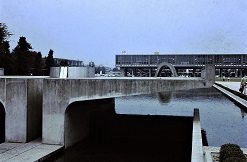
Hiroshima Peace Memorial Park commemorates the dropping of the atomic bomb on the city at 8.15 on the morning of August 6, 1945, which resulted in the death of as many as 140,000 people and having a significant effect in ending WW II. The area where the park is now was selected as the target due to it being the city’s political and busiest downtown commercial and residential district. In 1949 it was decided that the area would not be redeveloped but would be used as the location for the construction of a peace memorial. This would include a number of memorials and monuments, a museum and lecture halls these cover an area of 120,000 square metres so all monuments and memorials are in close proximity. The most recognisable sight is the Genbaku Dome, which is known as the A-Bomb Dome. Constructed in 1915, this was originally used to display commercial products. 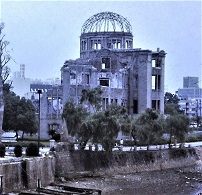 When the atomic bomb was dropped it exploded 160m (525ft) from the dome. Although gutting the building it was one of the few buildings in the city to avoid complete destruction. After the war it was decided to keep the structure as a reminder of the event. From 1950 through 1964, the Hiroshima Peace Memorial Park was established close to the Dome. In 1966 a resolution was adopted to permanently preserve the Dome. In 1996 it was designated a UNESCO World Heritage Site. The dome is framed when looking through the Peace Memorial Cenotaph. 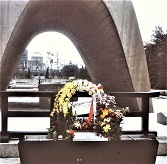 The Cenotaph is an arched tomb dedicated to all those who died due of the bomb, both in the initial blast and for those who were to die subsequently due to the exposure to radiation. Located below the arch is a stone chest holding a register of the names of those who died. The Cenotaph is an arched tomb dedicated to all those who died due of the bomb, both in the initial blast and for those who were to die subsequently due to the exposure to radiation. Located below the arch is a stone chest holding a register of the names of those who died.On the anniversary of the dropping of the bomb each year, at 8.15 am a ceremony is held where wreathes are laid at the Cenotaph, The Peace Clock Tower was built in 1967 and stands 20 metres tall. 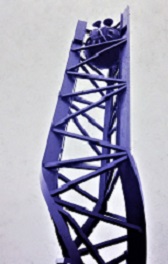 Made from three twisted iron pillars, the tower symbolizes the hands of the Hiroshima citizens, united in prayer for endless peace. The hands are holding the 2 metres-diameter clock which symbolizes the people of the world. The clock marks the time when the nuclear explosion occurred and every day at 8.15 am its chimes can be heard across the park. The Peace Bell was dedicated on September 20th 1964 as a symbol of the anti-war movement and the campaign against nuclear weapons.  The bell hangs inside a small open-sided structure and features a map of the world and series of engravings with inscriptions in Greek, Sanskrit and Japanese, which translate as "Know yourself." In front of the structure is a sign which invites visitors to toll the bell for peace. Children's Peace Monument is a bell and a bronze crane wind chime suspended from the inside of the structure’s dome. 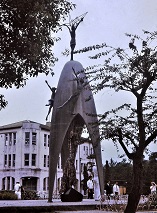 Attached to the monument are three angles. At the base of the Monument is a black marble slab which is inscribed with: Attached to the monument are three angles. At the base of the Monument is a black marble slab which is inscribed with:Unveiled on 5 May 1958 the monument was funded by the money collected by school children to commemorate Sadako Sasaki, a young girl whose statue showing her with outstretched arms and a crane above her head, is on top of the memorial. Sadako died from leukaemia on October 25, 1955 due to the radiation from the bomb. Before she died, she wanted to create a thousand paper cranes, as tradition says that if one creates a thousand cranes, they are granted a wish. Sadako's wish was to have a world without nuclear weapons. A paper crane being a symbol of peace. Hanging in the middle of the monument are the many paper cranes that visitors attach to the monument. The Flame of Peace commemorates the many people who were not able to find water following the bomb and died due to the sickness resulting from the heat rays and fires. 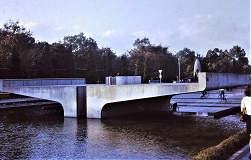 The sculpture represents two wrists joined together, and the two wings on each side represent two palms facing upwards towards the sky. The flame on top of the sculpture was lit in 1964 and will not be extinguished until the world is rid of all nuclear weapons. It is both a symbol of hope and a protest against the use of nuclear weapons. Past the Flame of Peace at the end of the park is the Hiroshima’s Peace Memorial Museum. 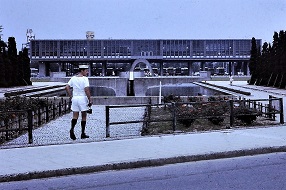 This opened in 1955 with the purpose of displaying the effects of the atomic bomb dropped on the city and consequently its effects on the world. On display are artefacts belonging to the victims, photographs of Hiroshima before and after the bombing and other exhibits demonstrating both the immediate impact of the bombing and its after-effects. Many of the exhibits have an emotional effect on visitors. |
|
|
|
|
|||
All Photographs were taken by and are copyright of Ron Gatepain
| Site Map |